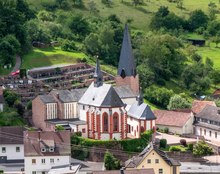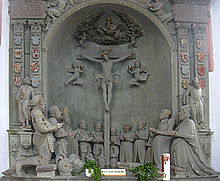Hessenthal pilgrimage church
Hessenthal in the town district of Mespelbrunn is a Marien - Sanctuary in Spessart . It is the burial place of the Echter von Mespelbrunn family and contains a Lamentation of Christ identified as an early work by Tilman Riemenschneider .
In terms of building history and style, there are parallels to the pilgrimage church Maria to the rough wind in Alzenau - Kälberau .
Pilgrimages take place in Hessenthal five times a year: Easter, Whitsun, Assumption of Mary (August 15th), Birth of Mary (September 8th) and Sacrifice of Mary (November 21st), each with a light procession the evening before.
Building history

According to a legend, the origins of the Hessenthal pilgrimage are believed to be in the 13th century or earlier. A church in Hesilndal was first mentioned in a document in 1293, but nothing of the architectural history has survived from this time. Today's complex is in three parts, consisting of
- the late Gothic chapel (real tomb),
- the smaller Gnadenkapelle in a style comparable to the Marien-miradenbild as well
- an extension by Hans skull from 1954, which contains the group of sculptures attributed to Tilman Riemenschneider.
The late Gothic pilgrimage chapel was built in 1439 after a date in the choir vault keystone . The chapel of grace was added to the north side of the chapel, connected by a defensive wall, in 1454 (dating in the door post).
Both chapels were extended by their long houses in the 17th century. On the mountain side there was a retaining wall with another chapel (the so-called high cross ).
Similar to Kälberau, the original pilgrimage church had become too small after the Second World War due to the large number of pilgrims returning from the war. Here, too, the Würzburg cathedral master builder Hans Skull was commissioned to build a new church. For this purpose, part of the nave of the old pilgrimage chapel was demolished and the high cross torn down.
Renovations took place in 1968/70, 1978/79 and for the 700th anniversary celebration in 1993.
Building description and equipment
The old pilgrimage chapel
Access to the single-nave chapel with Lanzett- tracery windows and skylights is now possible only from the interior of the new pilgrimage church. The church interior is flat covered; Under the triumphal pointed arch one arrives at the choir with five-eighth end and late Gothic reticulated vault. In the two keystones , Christ and Mary with child are depicted.
The most important piece of equipment is the epitaph for Peter III. Echter and Gertraud von Adolzheim , which Dietrich Echter commissioned from Erhard Barg in Schwäbisch Hall in 1582 for himself and his family. Christ is depicted on the cross, with Dietrich's parents Peter III kneeling below. Echter and Gertraud von Adelsheim and his siblings Adolf, Prince-Bishop Julius Echter , Sebastian, Valentin, Theoderich, Cordula, Magdalena and Margarete. The family coats of arms are affixed to the pilasters symmetrically to the left and right of the sculptural group of sculptures, below Peter on the left and Paul on the right. Above the tomb there is a medallion with a resurrection scene, surrounded by the three Pauline virtues of faith, hope and love.
Two other epitaphs also concern the Echter family: In the nave on the right are the brothers Philip II and Philip III. shown kneeling as a knight before Christ on the cross (also 1583 by Erhard Barg). The tomb for Elisabeth von Werdenberg (deceased in 1536) in the nave on the left is not fully plastic and is a generation older.
In addition, the church interior contains a number of other real grave slabs of varying quality, some in a rudimentary state of preservation.
The three baroque altars - high altar and two side altars - were made in 1686 by the Aschaffenburg court carpenter Peter Gießer . The painter of the high altar painting - Holy Family - is unknown. The late baroque side altar paintings depicting Michael and Sebastian are also works from Aschaffenburg ( Edmund Seeland , dated 1799).
The Chapel of Grace
The late Gothic architectural style - single-nave chapel with lancet tracery windows and roof turrets - is comparable to the old pilgrimage chapel, but the design is only slightly smaller. The nave has a flat roof, the choir has a ribbed vault with the coat of arms of the Echter family in the keystone.
The miraculous image is a late Gothic Pietà from around 1480 of rural origin with peculiar proportions; later overpaintings were taken back. Integrated into an Aschaffenburg baroque altar (completed in 1718), the entire design appears stylistically heterogeneous.
Cultivation of Hans skull
The new pilgrimage church is a simple hall church with a separate pointed-headed tower; The special thing about it is the lighting architecture, which is implemented in a similar way to that in Kälberau: wide strips of glass let in plenty of daylight into the church space under the flat prestressed concrete ceiling, from which glass light pendulums hang down on long strings that are natural on cloudy days or at dusk Creatively complement light with artificial light; an idea that is characteristic of church interiors from the 1950s, as can also be illustrated in the buildings by Dominikus Böhm and his son Gottfried .
Since 1967, a neo-expressionist Way of the Cross by the Aschaffenburg artist Siegfried Rischar has been running along the right inner wall under the light strips . In a reduced form and color scheme (limited to gray, white and brown) the work underlines the simplicity of the church interior.
Two major works of art history in the Spessart are diametrically opposed to this spatial effect:
- The conception of the Lamentation of Christ was mostly addressed by art historians after controversial discussions as an early work by Tilman Riemenschneider (around 1485). However, it is debatable how much of this was done by the artist personally. Another open question is the original location of the Pietà , surrounded by Joseph of Arimathea , Nicodemus and Maria Magdalena ; a John who belonged to this group is lost. What is certain is that the sculptures came to Hessenthal in 1728 and were integrated into the existing baroque altar. The arrangement of the figures may have been different before. A more mature depiction of comparable iconography, carried out by the master himself according to the prevailing opinion, can be found in the parish church of St. Peter and Paul (Großostheim) .
- The monumental crucifixion group behind the high altar is the last work of the Mainz sculptor Hans Backoffen (created in the year of his death in 1519). It previously stood in the demolished Hochkreuz chapel. Christ is depicted on the cross in victory pose, flanked by the crosses with the two thieves. An angel figure hovers over the head of the repentant thief on the left, a devil over that of the right. Mary and John stand under the cross in mourning pose, Mary Magdalene kneels. The attention to detail of the physicality, the folds of clothing and the agitation of the emotional expression are signs of the renaissance that has arrived north of the Alps.
literature
- Karl-Heinz Bachmann, Wolfgang Specht: Faith, Miracles, Art and Money. 700 years of pilgrimage to Hessenthal. Mespelbrunn municipality, Mespelbrunn 1993.
- Wolfgang Specht: Hessenthal pilgrimage church. (Schnell-Kunstführer, No. 663.) 13th edition, Schnell & Steiner, Regensburg 2003, ISBN 3-7954-4422-5 .
- Manfred Badum: The real epitaph in the pilgrimage church of Hessenthal (Mespelburnner Schriften Nr. 2) Catholic parish Hessenthal-Mespelbrunn, Mespelbrunn 2017
Web links
- Hessenthal pilgrimage church on the website of the parish Hessenthal-Mespelbrunn
- Opinions of Riemenschneider (PDF file; 60 kB)
Coordinates: 49 ° 55 '36.8 " N , 9 ° 17' 2.8" E



